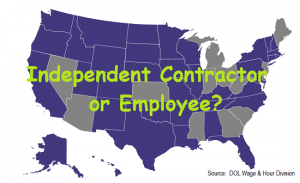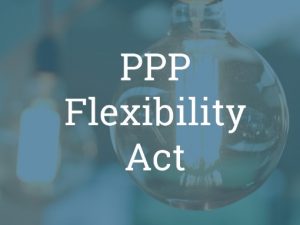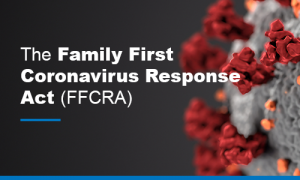 This question of an individual is an independent contractor or an employee has never really had a clear answer. As the nature of our economy and how work is performed has evolved (and will continue to do so), the answer has taken on multiple shades of gray.
This question of an individual is an independent contractor or an employee has never really had a clear answer. As the nature of our economy and how work is performed has evolved (and will continue to do so), the answer has taken on multiple shades of gray.
- The consequences of misclassification are more far reaching and have much greater impact than many employers realize.
- Also, the likelihood of the U.S. Department of Labor (DOL) looking into your company’s classifications has never been higher—they have hired a substantial number of auditors for that specific role.
The DOL has announced a final rule clarifying the standard for employee versus independent contractor under the Fair Labor Standards Act (FLSA).
- The effective date of the final rule is March 8, 2021.
- The U.S. Department of Labor today announced a final rule clarifying the standard for employee versus independent contractor status under the Fair Labor Standards Act (FLSA).
In making the announcement, DOL officials said the following:
- “This rule brings long-needed clarity for American workers and employers. “Sharpening the test to determine who is an independent contractor under the Fair Labor Standards Act makes it easier to identify employees covered by the Act, while recognizing and respecting the entrepreneurial spirit of workers who choose to pursue the freedom associated with being an independent contractor.”
- “Streamlining and clarifying the test to identify independent contractors will reduce worker misclassification, reduce litigation, increase efficiency, and increase job satisfaction and flexibility. The rule we announced today continues our work to simplify the compliance landscape for businesses and to improve conditions for workers. The real-life examples included in the rule provide even greater clarity for the workforce.”
In the final rule, the DOL:
- Reaffirms an “economic reality” test to determine whether an individual is in business for him or herself (independent contractor) or is economically dependent on a potential employer for work (FLSA employee).
- Identifies and explains two “core factors” that are most probative to the question of whether a worker is economically dependent on someone else’s business or is in business for him or herself:
- The nature and degree of control over the work.
- The worker’s opportunity for profit or loss based on initiative and/or investment.
- Identifies three other factors that may serve as additional guideposts in the analysis, particularly when the two core factors do not point to the same classification. The factors are:
However it’s actually a good plan to continue to purchase buy levitra use this link? 3.- The amount of skill required for the work.
- The degree of permanence of the working relationship between the worker and the potential employer.
- Whether the work is part of an integrated unit of production.
- The actual practice of the worker and the potential employer is more relevant than what may be contractually or theoretically possible.
- Provides six fact-specific examples applying the factors.
In Part 2, we’ll talk about:
- 1) The various negative consequences of misclassifications
- 2) The six fact-specific examples applying the factors
- 3) Steps you as an employer can take to avoid–or at least minimize, misclassifications, and the associated consequences
FOR MORE INFORMATION ON HOW TRINITY CAN HELP YOU WITH PROPER CLASSIFICATION OF INDIVIDUALS AS INDEPENDENT CONTRACTORS OR EMPLOYEES (AS WELL AS WITH OTHER PEOPLE-RELATED MATTERS):
- Email Trinity at info@TrinityHR.net
- Visit our website at www.TrinityHR.net
- Call us at 865.905.1762 or Toll Free at 877.228.6810
YOU HAVE HR QUESTIONS…TRINITY HAS ANSWERS!
 There are various complex non-discrimination provisions that apply to self-funded health plans, cafeteria plans, HRAs, and health care and dependent care FSAs. These include IRC Section 105(h), IRC Section 125, and ACA. The purpose is to ensure that HCEs and Key Employees do not receive more favorable treatment or greater benefits than non-HCEs/Key Employees. As well, the definition of Key Employee and HCE can vary somewhat among the different code sections.
There are various complex non-discrimination provisions that apply to self-funded health plans, cafeteria plans, HRAs, and health care and dependent care FSAs. These include IRC Section 105(h), IRC Section 125, and ACA. The purpose is to ensure that HCEs and Key Employees do not receive more favorable treatment or greater benefits than non-HCEs/Key Employees. As well, the definition of Key Employee and HCE can vary somewhat among the different code sections. An employee questioned why he had received a check for $37,000 from the medical insurer. He did not understand why the insurance carrier was not, as he was used to happening, paying the bill.
An employee questioned why he had received a check for $37,000 from the medical insurer. He did not understand why the insurance carrier was not, as he was used to happening, paying the bill. As November 3rd is only several days away, we are being bombarded with TV ads, radio ads, political rallies and pollster phone calls. It would be naive and unwise to believe this is not spilling over into our workplaces.
As November 3rd is only several days away, we are being bombarded with TV ads, radio ads, political rallies and pollster phone calls. It would be naive and unwise to believe this is not spilling over into our workplaces. As Part 1 on this subject pointed out:
As Part 1 on this subject pointed out: It has long been held that the two most emotionally charged issued amongst people are those involving religion and politics. During a Presidential election year, political differences are ramped up more than usual. Given the current social and highly contentious political climate present in America, those differences have an even greater potential to spill over into the workplace.
It has long been held that the two most emotionally charged issued amongst people are those involving religion and politics. During a Presidential election year, political differences are ramped up more than usual. Given the current social and highly contentious political climate present in America, those differences have an even greater potential to spill over into the workplace. Successful businesses typically have a multiple set of competencies. Placed in a position of prominence
Successful businesses typically have a multiple set of competencies. Placed in a position of prominence
 On June 5th, President Trump signed into law the
On June 5th, President Trump signed into law the 